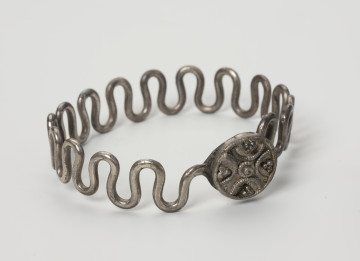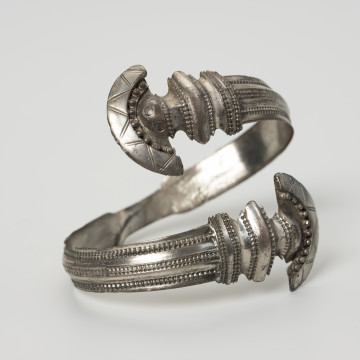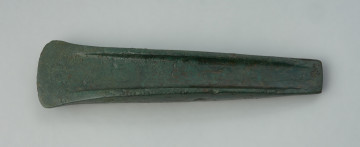
Wave bracelet
150 — 200
National Museum in Szczecin
Part of the collection: Antiquity
Accidental finds from 1881 from the village of Gronowo (municipality of Złocieniec, Drawsko district, West Pomeranian Province; German name: Groß Grünow, Kr. Dramburg) led Pastor Plato to the discovery of one of the most important sites of the Wielbark culture in Pomerania. The pastor, native of Złocieniec, was the first to pay attention to the earth mounds in the forest and correctly interpreted them as barrow burials. He also conducted amateur excavations of the site in 1881, 1887 and 1890. Furthermore, in 1926, during the construction of a road to Złocieniec, an inhumation grave with Roman imports was found, which is known in the literature today as "grave 1/1926". At the turn of 1939 and 1940, during the construction of the Berlin-Szczecin-Gdańsk motorway, the area of the cemetery was first assessed. Several pit graves were then discovered and explored by local archaeologists Heinz Hinz and Dr Faust. The area of the cemetery was reforested, as the construction of the aforementioned motorway was abandoned between 1940 and 1941. Methodical excavations during which the aforementioned vase was discovered did not take place until between 1973 and 1977 under the supervision of Ryszard Wołągiewicz from the museum in Szczecin. In total, 56 urned cremations and inhumations including 49 covered by barrow mounds were discovered in Gronów. A dark-brown, two-handle vase, decorated on the body with roughened stripes of a double zigzag, served as an urn in a cremation burial (grave no. 1), covered by a barrow mound (barrow no. 20). The grave goods of a female who died between 20 and 30 years of age included a decorated sandstone spindle whorl and a damaged silver fibula with three crests on a bow, which dates both the presented urn and the entire burial site to the 2nd half of the 2nd century AD.
Author / creator
Object type
ash urn, tureen
Technique
manual modelling
Material
ceramic
Origin / acquisition method
field research
Creation time / dating
Creation / finding place
Owner
Muzeum Narodowe w Szczecinie
Identification number
Location / status

150 — 200
National Museum in Szczecin

150 — 200
National Museum in Szczecin

around 1500 p.n.e. — 1300 p.n.e.
National Museum in Szczecin
DISCOVER this TOPIC
National Museum in Lublin
DISCOVER this PATH
Educational path